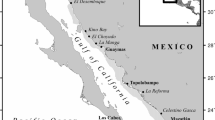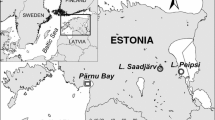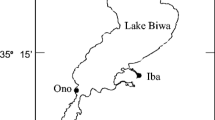Abstract
Relationships between male size, number, and weight of ‘newborn’ were determined in the seaweed pipefish, Syngnathus schlegeli, with paternal care of embryos in the brood pouch. While the number of newborn increased linearly with the increase in male size, the pouch volume increased exponentially with the male size. This resulted in embryo density in the pouch negatively correlating with the male size. Newborn dry weight was negatively correlated with the embryo density in the pouch. Thus, larger males were considered to brood embryos at lower densities and give ‘birth’ to heavier newborn. Neither paternal size nor embryo density seemed to have an effect upon developmental stage and total length of the newborn. Substantial weight loss of embryos during incubation indicated that paternal nutritional contribution to embryos is insignificant; therefore, the tendency of larger males to produce heavier newborn may not relate to allocation of paternal nourishment. Because egg weight increased with the female size, larger males are considered to receive the eggs of larger females and give birth to heavier newborn that developed from heavier eggs. Lower embryo density in larger males is attributable to the larger size of the heavier eggs. Assuming the pouch to be a cylindrical tube and the egg to be a sphere, geometrical calculations revealed that the relationship between the volumetric fraction of the pouch used by eggs (i.e. functional volume) and the male size was negatively quadric and had a peak. Increase in egg diameter increased the male size at which the functional volume of the pouch is maximized. Thus it appears that the size relationship of mates in pipefish is related to effective use of the pouch space.
Similar content being viewed by others
References cited
Ahnesjö, I. 1992a. Consequences of male brood care: weight and number of newborn in a sex-role reversed pipefish. Func. Ecol. 6: 274–281.
Ahnesjö, I. 1992b. Fewer newborn result in superior juveniles in the paternally brooding pipefish Syngnathus typhle L. J. Fish Biol. 41(suppl B): 53–63.
Azzarello, M.Y. 1991. Some questions concerning the Syngnathidae brood pouch. Bull. Mar. Sci. 49: 741–747.
Berglund, A. 1994. The operational sex ratio influences choosiness in a pipefish. Behav. Ecol. 5: 254–258.
Berglund, A. & G. Rosenqvist. 1993. Selective males and ardent females in pipefishes. Behav. Ecol. Sociobiol. 32: 331–336.
Berglund, A., G. Rosenqvist & I. Svensson. 1986a. Reversed sex roles and parental energy investment in zygotes of two pipefish (Syngnathidae) species. Mar. Ecol. Prog. Ser. 29: 209–215.
Berglund, A., G. Rosenqvist & I. Svensson. 1986b. Mate choice, fecundity and sexual dimorphism in two pipefish species (Syngnathidae). Behav. Ecol. Sociobiol. 19: 301–307.
Berglund, A., G. Rosenqvist & I. Svensson. 1988. Multiple matings and paternal brood care in the pipefish Syngnathus typhle. Oikos 51: 184–188.
Berglund, A., G. Rosenqvist & I. Svensson. 1989. Reproductive success of females limited by males in two pipefish species. Amer. Nat. 133: 506–516.
Gordina, A.D., L.S. Oven, A.V. Tkach & T.N. Glimova. 1991. Distribution, reproduction, and diet of the pelagic pipefish, Syngnathus schmidti, in the Black Sea. J. Ichthyol. 31: 110–119.
Gray, J. 1927. The growth of fish. I. The relationship between embryos and yolk in Salmo fario. Br. J. Exp. Biol. 4: 215–225.
Haresign, T.W. & S.E. Shumway. 1981. Permeability of the marsupium of the pipefish Syngnathus fuscus to [14C]-alpha amino isobutylic acid. Comp. Biochem. Physiol. 68(A): 603–604.
Hipfner, J.M. & A.J. Gaston. 1999. The relationship between egg size and posthatching development in the thick-billed murre. Ecology 80: 1289–1297.
Hopkins, T.E., M.B. Eldridge & J.J. Cech, Jr. 1995. Metabolic costs of viviparity in yellowtail rockfish, Sebastes flavidus. Env. Biol. Fish. 43: 77–84.
Hutchings, J.A. 1991. Fitness consequences of variation in egg size and food abundance in brook trout Salvelinus fontinalis. Evolution 45: 1162–1168.
Kronester-Frei, A. 1975. Light and electron microscopical studies of the brood epithelium of the male Nerophis lumbriciformis (Pennant 1776), Syngnathidae, with special reference to the structural changes in the egg membrane (zona radiata). Forma et Functio 8: 419–462 (in German).
Noumura, T. 1957–1960. Induction of marsupium-like structure by testosterone in females of the pipefish, Syngnathus schlegeli. J. Fac. Sci. Tokyo Univ. Zool. 8: 515–520.
Quast, W.D. & N.R. Howe. 1980. The osmotic role of the brood pouch in the pipefish Syngnathus scovelli. Comp. Biochem. Physiol. 67(A): 675–678.
Rosenqvist, G. 1990. Male mate choice and female–female competition for mates in the pipefish Nerophis ophidion. Anim. Behav. 39: 1110–1115.
Scrimshaw, N.S. 1945. Embryonic development in poeciliid fishes. Biol. Bull. 88: 233–246.
Seno, H. 1993. Syngnathidae. pp. 478–489, 1293–1294. In: T. Nakabo (ed.) Fishes of Japan with Pictorial Keys to the Species, Tokai University Press, Tokyo (in Japanese).
Svensson, I. 1988. Reproductive costs in two sex-role reversed pipefish species (Syngnathidae). J. Anim. Ecol. 57: 929–942.
Takai, T. & A. Mizokami. 1959. On the reproduction, eggs and larvae of the pipefish, Syngnathus schlegeli Kaup. Nou SuiKou Kenhou 8: 85–89 (in Japanese).
Tamura, O. & T. Rikimaru. 1957. On the larvae and young of a goby, Syngnathus schlegeli Kaup. Bull. Fac. Fish. Nagasaki Univ. 5: 70–74 (in Japanese).
Tsuruta, Y. 1992. Reproduction in the Japanese anchovy (Engraulis japonica) as related to population fluctuation. Bull. Nat. Res. Inst. Fish. Eng. 13: 129–168 (in Japanese).
Watanabe, S. & Y. Watanabe. 2001. Brooding season, sex ratio and brood pouch development in the seaweed pipefish, Syngnathus schlegeli, in Otsuchi Bay, Japan. Ichthyol. Res. 48: 155–160.
Watanabe, S., M. Hara & Y. Watanabe. 2000. Male internal fertilization and introsperm-like sperm of the seaweed pipefish (Syngnathus schlegeli). Zool. Sci. 17: 759–767.
Watanabe, S., T. Kaneko & Y. Watanabe. 1999. Immunocytochemical detection of mitochondria-rich cells in the brood pouch epithelium of the pipefish, Syngnathus schlegeli: structural comparison with mitochondria-rich cells in the gills and larval epidermis. Cell Tissue Res. 259: 141–149.
Wourms, J.P. 1981. Viviparity: the maternal–fetal relationship in fishes. Amer. Zool. 21: 473–515.
Yanagawa, H. 1981. Studies on the local form and dispersal of the chika, Hypomesus pretiosus japonicus (Brevoort) in Japan. Mem. Fac. Fish. Hokkaido Univ. 27: 1–78.
Author information
Authors and Affiliations
Rights and permissions
About this article
Cite this article
Watanabe, S., Watanabe, Y. Relationship Between Male Size and Newborn Size in the Seaweed Pipefish, Syngnathus Schlegeli . Environmental Biology of Fishes 65, 319–325 (2002). https://doi.org/10.1023/A:1020510422509
Issue Date:
DOI: https://doi.org/10.1023/A:1020510422509




